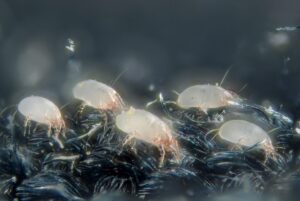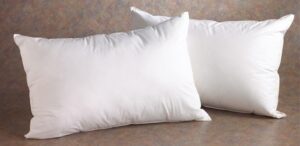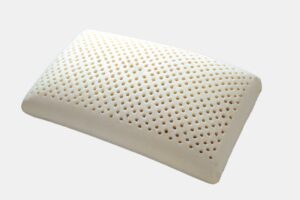 Recently in one of the allergy Facebook groups of which I’m a part someone asked an interesting question: If you’re covering your pillow with multiple layers of organic cotton, but allergic to the pillow’s fill, does what’s inside the pillow really matter? This question was a very timely one for me, because I changed all my bedding except the polyester fill pillows to cotton and wool two weeks ago. This includes the dust mite covers – they were changed from laminated cotton to organic cotton. I also received a lot of 100% cotton underwear around this time, including the seams, which are sewn with cotton thread.
Recently in one of the allergy Facebook groups of which I’m a part someone asked an interesting question: If you’re covering your pillow with multiple layers of organic cotton, but allergic to the pillow’s fill, does what’s inside the pillow really matter? This question was a very timely one for me, because I changed all my bedding except the polyester fill pillows to cotton and wool two weeks ago. This includes the dust mite covers – they were changed from laminated cotton to organic cotton. I also received a lot of 100% cotton underwear around this time, including the seams, which are sewn with cotton thread.
I’ve also been noticing a somewhat horrifying symptom of my contact allergies – nonspecific pain. I believe this symptom is specifically tied to my propylene glycol allergy. Polyethylene glycol can also create a reaction (cross-react) in people who have a propylene glycol allergy, and polyethylene glycol is used in excess to make polyester. (Polyester is consequently used to make spandex/lycra/elastane.) This pain can be joint pain, pain like a bone bruise, pain like soft tissue injury or strain, or other; it’s really hard to pin down. Before Christmas and over the December holidays, I had regular, sharp pains from the top of my hip bones to the bottom of my ribs, switching sometimes, and getting worse when I got up from a sitting position. I also had pain at the top of my bum, around the gluteus minimus and gluteus medius. Sometimes I had pain down the sides of my legs, near the side seams on my pants. Since I stopped wearing the PJ pants that had a polyester-based satin waistband, the hip and rib pain disappeared. Since wearing 100% cotton underwear more often, the gluteus pain has mostly gone away, and even the outside leg pain has diminished considerably. This may seem like a strange digression in my talk about pillows, but bear with me.
 When I switched the bedding, I switched the dust mite case as well, to 100% cotton. 100% cotton dust mite covers are not as good as laminated (plastic-coated) cotton ones in that they have a slightly looser weave, and no waterproof (impermeable) layer. This means that they will not allow dust mites through, but they will allow bed bugs and moisture through. Before changing the dust mite cover from laminated cotton to 100% cotton, I was experiencing moderate eye symptoms about once every 5 to 7 days. I attributed some of this to my sweat helping me to absorb loose molecules from the polyester that migrated through my pillow case.
When I switched the bedding, I switched the dust mite case as well, to 100% cotton. 100% cotton dust mite covers are not as good as laminated (plastic-coated) cotton ones in that they have a slightly looser weave, and no waterproof (impermeable) layer. This means that they will not allow dust mites through, but they will allow bed bugs and moisture through. Before changing the dust mite cover from laminated cotton to 100% cotton, I was experiencing moderate eye symptoms about once every 5 to 7 days. I attributed some of this to my sweat helping me to absorb loose molecules from the polyester that migrated through my pillow case.
Within three days of switching the dust mite cover to 100% cotton (but not switching my pillow), I was noticing slightly increased eye symptoms (less intense, but more frequent), itching along the back of my neck and shoulders, and pain between my shoulder blades. My scalp was also having problems, particularly on the back and front sides, and a reactive lymph node on my jaw started acting up a lot, causing neck and jaw pain. I should point out that while I mostly sleep on my side, I often woke up on my back during this time. Luckily, the removal of plastic/synthetic barriers from my sleeping environment, and the addition of wool, made my sleep 95% less sweaty. This continued for a week. The fibres that go into these pillows are of all lengths, from long to fairly tiny, and every time you squish or hit a pillow, some of those fibres are released into the air. Hold a pillow in front of a bright, sunny window, and squish it firmly a few times to see. It’s not just surface dust.
 I suspected that my polyester fill pillow, combined with a more permeable dust mite cover, was the culprit, so I sat down at my sewing machine with my cotton barrier fabric and some kapok fibre (fluff from the seed pods of the kapok tree), and finally made myself that new pillow I’ve been planning. Total cost for kapok fill and 1/2 meter of wide fabric was about $30, though I also used cotton thread I already had on hand, and bought the cotton barrier fabric on clearance. I stuffed my new pillow into my (washed) 100% cotton dust mite cover, put a clean cotton pillow case on top, and slept. (I should mention that I also washed myself. You have no idea how much kapok spreads until you try fluffing it to stuff a pillow. Let’s just say my hair and clothing looked like I’d been inside one of those Build-a-Bear stuffing machines, except with natural fibres. So did my sewing machine and floor, just from being in the vicinity of the stuffing process.) Overnight, the intense itching along the back of my shoulders and neck cleared up, though I had some residual itchiness on the sides of my neck. The pain between my shoulder blades disappeared, and the eye symptoms cleared up completely. My jawside lymph node stopped reacting, and the neck and jaw pain that had been plaguing me disappeared. It’s far too soon to judge my scalp symptoms, since they tend to have a slower recovery, but my head hasn’t itched since the switch.
I suspected that my polyester fill pillow, combined with a more permeable dust mite cover, was the culprit, so I sat down at my sewing machine with my cotton barrier fabric and some kapok fibre (fluff from the seed pods of the kapok tree), and finally made myself that new pillow I’ve been planning. Total cost for kapok fill and 1/2 meter of wide fabric was about $30, though I also used cotton thread I already had on hand, and bought the cotton barrier fabric on clearance. I stuffed my new pillow into my (washed) 100% cotton dust mite cover, put a clean cotton pillow case on top, and slept. (I should mention that I also washed myself. You have no idea how much kapok spreads until you try fluffing it to stuff a pillow. Let’s just say my hair and clothing looked like I’d been inside one of those Build-a-Bear stuffing machines, except with natural fibres. So did my sewing machine and floor, just from being in the vicinity of the stuffing process.) Overnight, the intense itching along the back of my shoulders and neck cleared up, though I had some residual itchiness on the sides of my neck. The pain between my shoulder blades disappeared, and the eye symptoms cleared up completely. My jawside lymph node stopped reacting, and the neck and jaw pain that had been plaguing me disappeared. It’s far too soon to judge my scalp symptoms, since they tend to have a slower recovery, but my head hasn’t itched since the switch.
Having tried this three different ways, experiencing consequent symptoms of each, I can say this:
- If you are allergic to polyester and have a polyester fill pillow, do NOT put 100% cotton covers on it and expect everything to be fine. This is the worst combination you can use, as it allows the polyester fibres to exit your pillow and affect you the most. It goes without saying that you don’t want any partner(s) that sleep in your bed using this combination either. If the fibre is small enough to get out of your pillow, it can definitely float over to you on tiny air currents from your partner’s pillow.
- If you cannot afford a natural fibre pillow, use a cotton laminated dust mite protector on your synthetic-fill pillow. It will minimize migration of polyester fibres out of your pillow. It’s not the ideal solution, but it is the most affordable, and has the added bonus of protecting your pillow from moisture and at least somewhat from bed bugs.
- If you can afford the outlay, a 100% natural fibre pillow (casing and fill) and natural fibre dust mite cover are the best choice. Your pillow will be considerably less sweat-inducing, and no allergenic fibres from your pillow will be able to harm you, because they won’t be there.
 Other synthetic fibre fills should behave similarly to what I have described above. If you have a latex or rubber-filled pillow, and latex/rubber are issues for you, you may not have the same results because latex and rubber are not fibrous in nature, and thus their migration out of pillows will be different, including possible off-gassing. I do suspect that the ideal solution(s) may be similar to above.
Other synthetic fibre fills should behave similarly to what I have described above. If you have a latex or rubber-filled pillow, and latex/rubber are issues for you, you may not have the same results because latex and rubber are not fibrous in nature, and thus their migration out of pillows will be different, including possible off-gassing. I do suspect that the ideal solution(s) may be similar to above.
Have you had an allergy to your pillow? What did you do and how effective was it? Have you had painful reactions to polyester? Comment below.
